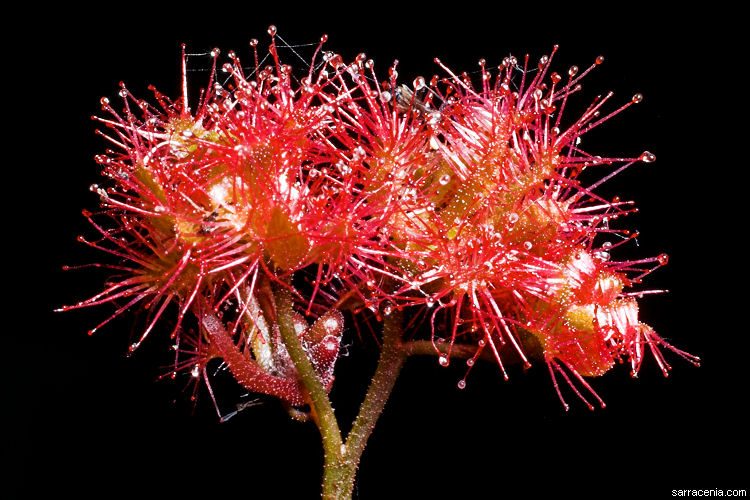
A final example:
In this, another highly advanced case, you can see what appears to be a normal
rosette of developing leaves. Presumably, with proper coddling, this structure could be coaxed to generate roots too.
Having obtained collecting permission from appropriate management authorities in the Wallowa-Whitman forest, I am doing some
long term cultivation studies of these plants to see if the abnormal flowering
behavior is fixed. My gut says that this is not genetically fixed, but wouldn't it
be interesting if it was? I'll keep the readership of Carnivorous Plant Newsletter
notified!
Having finished at this lake, I saw I had time to drive further west along my rocky forest road to
visit yet another site
(a small collection of lakes)
that I had been told also has carnivorous plants. The elevation of this second set of lakes was
1975 meters (6480') elevation (about 300 meters higher than
the first lake) so I anticipated a very interesting contrast between the two sites.
After a long and bone-chattering drive I arrived at the site, which was in a gentle
mountain saddle littered with deadwood from a fairly recent and apparently extreme forest fire. The sun was dropping in
the sky, so with time running short I started surveying the lake as efficiently as I could. After about 45 minutes of wasting
time with lakelets that turned out to be of no value to me, I turned my attention to the last lake at the site. This
lake
supported an extensive Carex meadow, consisting of a loosely knit mass of roots, leaves, and
decaying material; while often sturdy it was
also prone to collapsing under my weight. It was tricky travel.
I fell into a few sucker holes as I searched--fortunately only up to my waist to provide comedic relief--so soon I was
fully muddy and wet. I noticed that some dork had driven an all-terrain
vehicle on the fragile mat,
leaving tracks and torn Carex mat in its wake. What a jerk! I took some satisfaction in seeing the putz had plunged
into a large sucker hole; I hoped the subsequent inundation in cold water cracked its engine block. (I can dream, can't I?)
Unfortunately,
I just couldn't find any carnivorous plants in it. It was odd that I couldn't find
anything--the mat was unstable and undulated underfoot as so often Carex mats do, yet not even sprigs of
Utricularia were present. It was exciting
when I flushed a big buck deer about 5 meters from
me, but that was not quite was I was hoping for.
After a few hours, with sun dropping towards the horizon, I regrettfully
set a course across the sedge meadow back towards
my car.
I had slogged about halfway back to the car when I saw, in the shallows, a strand of something that looked
auspicious. Indeed, it was a bit--a very small bit--of Utricularia minor! I changed my bearing to take me closer to
the edge of the mat--near the oh-so-threatening open water of the lake--and soon found
Utricularia macrorhiza! Excellent! I spent a few minutes examining the plants, but saw nothing particularly notable
about them worth reporting upon. I continued car-ward.
As I trudged, the character of the ground changed suddenly. The sensation of walking on a sedge mat changed almost
instantly to the sensation of climbing on a gooey marshmallow mattress. I
had found a small floating Sphagnum mat! Although small (about 20×10 meters in size),
it was much like the mat at the lake I had been at earlier in the day, and housed
Drosera anglica in abundance. These plants, though, were smaller and were not flowering.
I wondered if the mat at this site was shrinking, growing, or stable?
Alas, it was late and the site was not particularly photogenic in the poor light, so after some notetaking I decided it
was time to return to my car without taking photographs. I looked at the dropping sun with concern--I did not relish
the notion of my car getting a flat tire in the night, stranding me on a mountain
road in the wrong state (in the eyes of my rental car agency) and without cell phone connections. I returned to my car
(alarming a family of campers, who thought that from my appearance I had been in some terrible life-threatening accident)
and drove away on the sharply rocky road.
After a long but blissfully uneventful drive,
I reached asphalt. But still, I had to shush deer and rodents as I navigated an interminable winding mountain road.
I was eventually delivered into the flats of northeastern
Oregon.
I anticipated with relish my arrival in
the lovely town of Enterprise, where I had reservations in a cozy little motel room. I was in
desperate need of a shower and exquisitely dry clothes. I was a mess!
I tried to call my wife, as I had been out of communication for a few days, but just I reached the land of
cell-phone-reception, my phone's battery lost the last few electrons it had. Drat!
My camera and
GPS batteries were also dead, but they--like me--would be recharged and renewed at my cozy little motel room.